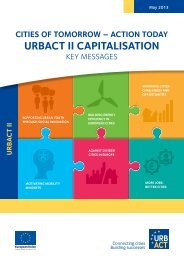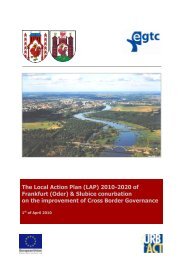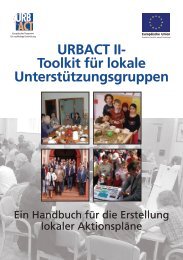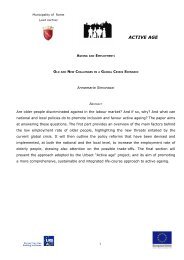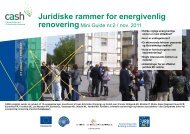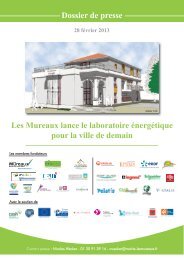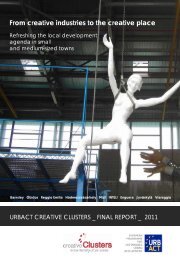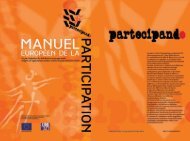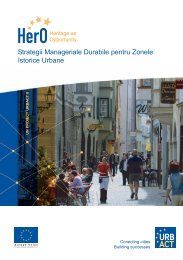ENTER.HUB_Baseline study PDF, 6 Mo - Urbact
ENTER.HUB_Baseline study PDF, 6 Mo - Urbact
ENTER.HUB_Baseline study PDF, 6 Mo - Urbact
Create successful ePaper yourself
Turn your PDF publications into a flip-book with our unique Google optimized e-Paper software.
EUROPEAN<br />
UNION<br />
European Regional<br />
Development Fund<br />
3.23 Themes, Macro themes and clustering<br />
3.231 10 Themes<br />
<strong>ENTER</strong>.<strong>HUB</strong> ASSUMPTIONS:<br />
1. <strong>ENTER</strong>.<strong>HUB</strong> focuses especially in PERIPHERAL CITIES/REALITIES, partly isolated from major<br />
international circuits of exchange. This because: 1. Of medium size and 2. Usually located<br />
between two large centres. We could advance that it makes more sense for Europe to invest<br />
in medium-sized cities, especially the most disadvantaged in terms of visibility, because this<br />
helps to rebalance and redistribute future investments: development of the peripheral cities –<br />
development of polycentrism<br />
2. CITIES are the CORE of the ECONOMIC and RELATIONAL DEVELOPMENT of a territory (Lisbon<br />
Agenda)<br />
3. KEY FACTORS described by the Lisbon Agenda as indicators of city attractiveness are transport<br />
connections, metropolitan transport, ICT infrastructure, environment, social fabric and<br />
culture. Thorough analysis and integrated propositions of these 5 fields is necessary to make<br />
them become the pillars of new innovative planning strategies, especially for middle-sized<br />
cities which aim to become ATTRACTIVE AND SMART CITIES.<br />
4. ACCESSIBILITY, among other factors, determines the COMPETITIVENESS of a city and a<br />
territory<br />
5. TRANSPORT is a major component of public service (Transport White Paper and Treaty of<br />
Rome)<br />
6. European network hubs have a strategic role in the regeneration of a city and a territory<br />
because of the direct INTERRELATIONSHIP between good ACCESSIBILITY to a city and its<br />
REGENERATION.<br />
7. in order to overcome the economic crisis, cities have to promote and better exploit the<br />
RELATIONAL NETWORKS AMONG PEOPLE, their sense of pride and belonging to their<br />
local/regional (and even EU) community and capitalize on the human resources<br />
8. High Speed (HS) and European corridors are the BACKBONE of Europe not only at an<br />
infrastructural level, but as a consequence influencing the level of interactions and economic<br />
and cultural development (according to the revised TEN-T policy).<br />
9. RAILWAY LINES, especially in the form of HSL, are at DIFFERENT LEVELS OF DEVELOPMENT<br />
across Europe. In the next few years they are bound to overtake air transport and to become<br />
the most important and environmental sustainable transport system, especially for the<br />
medium distances. This is in line with the EU communication “Keep Europe <strong>Mo</strong>ving, the<br />
“Connecting Europe Facility” and the Transport White Paper especially approach C and<br />
measures proposed, because railway development improves the accessibility through a<br />
sustainable and alternative mode to road and air mobility, able to reduce congestion and<br />
pollution.<br />
10. It is NOT ONLY CITIES with their railway junctions/transport interchanges that need to be<br />
exploited, but also the AREAS that SURROUND these hubs, that means, other cities in the<br />
area. The effects will then, albeit in a different way, be multiplied found over the whole<br />
catchment area.<br />
11. This urban CONFIGURATION (medium city and its surroundings, not only single city) will be<br />
INCREASINGLY PRESENT in the European context (as groups of cities will be served by these<br />
hubs).<br />
<strong>ENTER</strong>.<strong>HUB</strong> <strong>Baseline</strong> <strong>study</strong> 2012.10.31<br />
66



